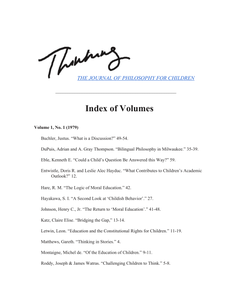The journal was a forum for the work of both theorists and practitioners of philosophical practice with children, and published such work in all forms, including philosophical argument and reflection, classroom transcripts, curricula, empirical research, and reports from the field. The journal also maintained a tradition in publishing articles in the hermeneutics of childhood, a field of intersecting disciplines including cultural studies, social history, philosophy, art, literature and psychoanalysis.
DOCUMENT

“Municipal Youth Work taken over by Christians”. (Binnenlands Bestuur, 2009) This heading refers to the work of Youth for Christ in an Amsterdam neighbourhood. This organisation, successful in Youth Work nationwide, last year came out first in an open competition of the Amsterdam district De Baarsjes. Because of this they were commissioned to undertake all the youth work in this multicultural neighbourhood. The conditions were not to evangelise and not to limit recruitment of personnel inside their own circle but to recruit from outside the organisation as well. When they later appeared to have put a job advertisement only on their own website, this led to heated debates. Finally Youth for Christ acknowledged and rectified this mistake. This example is a concrete illustration of the actual and sometimes delicate relationships between philosophy of life and social work
DOCUMENT

Using political discourse analysis, this book examines the extent to which the salient approaches of previous leadership generations have translated into present day policies shepherded in by Xi Jinping. On the strategic political level, the book includes comparisons of China's recent leadership periods with a focus on Xi Jinping's era, and contains examples of whether and how specific topics and tactics reoccur across generations. The state development strategy section then goes on to include chapters on shaping China’s strategic narratives, neoliberal discourse within state developmentalism, and keyword evolution. The practical policies part looks at the issues of re-education, health, class, and ethnicity, analysing how the leaders talk about China’s poor, frame the representations of megaprojects on social media, and discursively display diplomatic strength. As a study of the rule of Xi Jinping and the rhetoric of the contemporary Chinese political system, this book will be of huge interest to students and scholars of Chinese politics and political science more broadly.
LINK